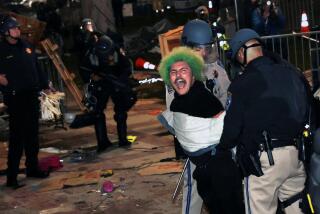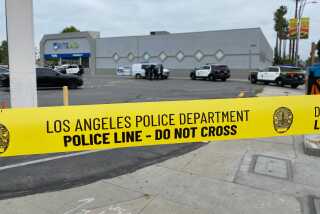Commentary : It’s Time to Rethink Use of Deadly Force Against Those Fleeing Police
On Sept. 19, Ernest Nunez was killed by a shotgun blast while fleeing from police officers in Santa Ana. The shotgun pellets entered his back and the back of his head, as one would expect in the case of flight without confrontation.
Nunez apparently had committed a felony and continued running away from pursuing officers despite repeated orders to halt, satisfying (under English common law) the two conditions necessary to justify killings by police officers.
Common law was the basis for Section 196 of the California Penal Code when it was enacted in 1872. It states: “Homicide is justifiable when committed by public officers . . . in arresting persons charged with felony, and who are fleeing from justice.” The wording of that law has not changed in all the years since enactment, and up until 1977 it was interpreted literally to mean that an officer was justified in shooting any fleeing felon--even when the felony consisted simply of stealing a dog, avocados or nuts of relatively modest value.
But in that year, the Court of Appeal in San Francisco construed that law to mean that deadly force could be used by police officers only if the felony in question was a violent (“atrocious”) one that could lead to death or serious injury, or there remained a serious risk to the officer or another person. That became, and remains, the law throughout the state since there was no contrary ruling by another appeals court or by the California Supreme Court.
The perspective was given nationwide force in 1985 when the U.S. Supreme Court declared unconstitutional all state laws that followed codified simple common law requirements, and adopted a standard similar to that of California.
Therefore, when it appears that an officer has shot a fleeing suspect who apparently has not committed a life-threatening felony, one typically finds such explanations by the officer as “The suspect reached for something in a glove compartment or in his (or her) pocket,” or “The hands of the suspect moved suspiciously about his (or her) waist.” If investigators, prosecutors or jurors accept the explanation, there is justification, meaning no crime was committed by the officer.
Furthermore, there is a tendency on the part of all three groups to believe the officer--there is, after all, a widespread sympathy with the travails of the police in the non-minority population, and it is easy to imagine that the police officer did perceive a furtive movement or a threatening stance.
That orientation toward sympathetic understanding is perhaps most noticeable in the case of investigators from offices of district attorneys (on the “roll-out” teams) who are, almost without exception, former police officers.
Consequently, very few criminal charges ever are filed against officers who have shot citizens, and only some of those lead to convictions. Incidentally, while juries are unlikely to find officers criminally liable, they are likely to award large sums to the survivors of police shootings and the relatives of non-survivors. These assessments are against taxpayers rather than officers.
Criminal action, though an intimidating threat in theory, thus is not much of a controlling force in actual operation. What other means of control are there? One begins to think of a possible need for more control in Orange County on considering the substantial escalation of officer-involved shootings within its boundaries in recent years. That escalation occurs in the context of a 1986 study that reported a 50% decrease in killings by police officers in 50 of our largest cities over a 14-year period in which the weaponry of criminals became more and more sophisticated. Moreover, the decrease in killings by the police occurred along with an even larger reduction in the number of police officers killed--that is, reduction in shootings by officers has not been associated with greater risk to officers.
Studies have shown two effective modes of controlling police deadly force. Both are protective of the well-being of officers and the values of society. The first method involves a carefully developed departmental policy statement presenting acceptable departmental procedure, accompanied by a strict enforcement attitude on the part of police officials, particularly the chief.
The second is a comprehensive training approach based on an attitude of protection of life--all life--rather than on the archaic “officer survival” mentality. It is worth noting that violations of departmental policy mentioned in the first method are dealt with by administrative sanctions rather than criminal charges, varying from written reprimand through suspension to dismissal. In California, officers generally are well-insulated from abuse of such administrative control by the legal and political advocacy of their strong associations and by the Public Safety Officers Procedural Bill of Rights Act of 1976.
Many cities have revised policy and procedures to control shootings by police only after the occurrence of riots or near-riots in their minority communities (where such shootings predominantly occur), or the awards of large sums in response to claims and lawsuits.
Of course, there are many people, particularly among those in law enforcement, who do not believe in control of police deadly force beyond the limits set in common law. They believe that if a person commits a more serious crime and refuses to stop on orders from a police officer, he or she deserves to be killed. To them, more shootings and killings are indications that the police are doing a better job.
However appropriate this sentiment may have been in the context of the society of 18th-Century England, or even the society of a generation ago in the United States, it is markedly out of step with the broad concerns for human life and welfare that are pervasive forces in this country today.
Recognizing and accepting those concerns alongside the costs of excessive use of deadly force in terms of the building resentments among minority citizens and the settlement of claims and suits, it seems clear that action is called for at this time. The escalation in shootings and killings by the police in Orange County may be a sign that the system is not operating in the best interests of society.
More to Read
Sign up for Essential California
The most important California stories and recommendations in your inbox every morning.
You may occasionally receive promotional content from the Los Angeles Times.










